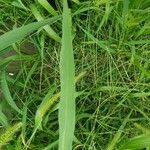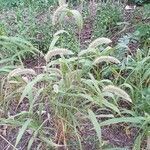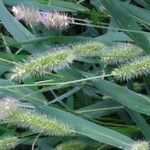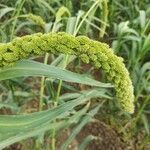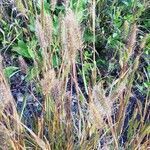Annual. Culms robust, erect, up to 150 cm, nodes glabrous. Leaf sheaths glabrous or pubescent, ciliate; leaf blades linear-lanceolate, 15–45 × 0.6–2 cm, usually glabrous; ligule 1–3 mm. Panicle dense, lobed, 6–40 × 0.5–5 cm, very variable, erect or pendent when mature; spikelets subtended by several bristles 1–5 times spikelet length; axis villous. Spikelets elliptic to ovate or subglobose, 2–3 mm, yellow, brown, orange or purple; lower glume 1/3–1/2 as long as spikelet; upper glume about as long as spikelet, 5–7(–9)-veined, obtuse; lower lemma equal to spikelet, 5–7-veined; lower palea absent or narrow, up to 1/2 as long as lemma; upper floret yellow or orange-yellow, oblong or ovate-oblong, cartilaginous, deciduous at maturity, finely rugose to smooth and shiny. Fl. and fr. summer to autumn. 2n = 18.
Annual, 0.35-1.50 m high; culms erect, solitary to densely tufted, node glabrous; leaves mainly cauline. Leaf blade 150-450 x 6-20 mm, expanded, linear, glabrous, usually scabrid; ligule a fringed membrane or a fringe of hairs. Inflorescence a spike-like panicle, 8-24 mm wide; spikelets subtended by 2-5 bristles; bristles up to 15 mm long, scabrid, slender, purple or yellow, persisting on axis after spikelets fall. Spikelets 2.0-3.5 mm long, dorsiventrally compressed; lower glume 3-nerved; upper glume 5-7-nerved. Florets 2; lower floret sterile rarely with a minute palea; upper floret bisexual, lemma indurated, smooth and shiny or rugulose, entire; upper floret reluctantly disarticulating; anther 0.5-1.0 mm long. Flowering time Jan.-Apr.
Annual 350-1500 mm high; leaves mainly cauline; culm erect, solitary to densely tufted, node glabrous. Leaf blade 150-450 x 6-20 mm, expanded, linear, glabrous, usually scabrid. Inflorescence 8-24 mm wide, spike-like; bristles 2-5, up to 15 mm long, slender, scabrid, purple or yellow. Spikelet 2.0-3.5 mm long; lower floret persistent, upper floret reluctantly disarticulating; lower glume 3-nerved; upper glume 5-7-nerved; lower floret usually reduced to a lemma, rarely with a minute palea; upper lemma smooth, shiny or rugulose; anther 0.5-1.0 mm long.
An annual grass. It grows 1-1.5 m tall. It can be tinged with purple colour. The stalks are upright and the section between the nodes is hollow. It develops tillers from the base. It has along leaf sheath. The leaf blade is 30-45 cm long by 1.2-2.5 cm wide. It has a prominent midrib and tapers towards the tip. The flower is a spike-like branching flower 7.5-25 cm long by 1.2-5 cm wide. The side branches carry 6-12 small spikes each with 1-3 bristles. The mature grain is 2 mm long. There are many named cultivated varieties.
Vegetatively like the larger forms of no. 5 [Setaria viridis (L.) P. Beauv.], with lobulate infls, but with larger spikelets ca 3 mm, the fertile lemma smooth and shiny, disarticulating above the more persistent glumes and sterile lemma; sterile palea half as long as its lemma, which is usually shorter than the fertile lemma; 2n=18. Old-World cultigen, thought to be derived from no. 5, cult. for fodder or grain, and occasionally found as a weed nearly throughout our range.
Annual; up to 1.5 m high; solitary to densely tufted. Culm nodes glabrous; leaves mainly cauline. Leaf blades 150-450 x 6-20 mm. Flowers: panicle spike-like; 8-24 mm wide; spikelets 2.0-3.5 mm long; lower floret persistent; upper floret reluctantly disarticulating at maturity; bristles 2-5; antrorsely barbed; lower glume 3-nerved; upper glume 5-7-nerved; upper lemma smooth or rugulose; lower palea absent or very reduced.
Annual, culms erect, solitary to densely tufted, up to 1.5 m high. Leaf blades 150-450 mm long, 6-20 mm wide, leaves mainly cauline. Culm nodes glabrous. Spikelets 2.0-3.5 mm long. Panicle spike-like, 8-24 mm wide; spikelets disarticulating above glumes; lower glume 3-nerved; lower lemma smooth.



